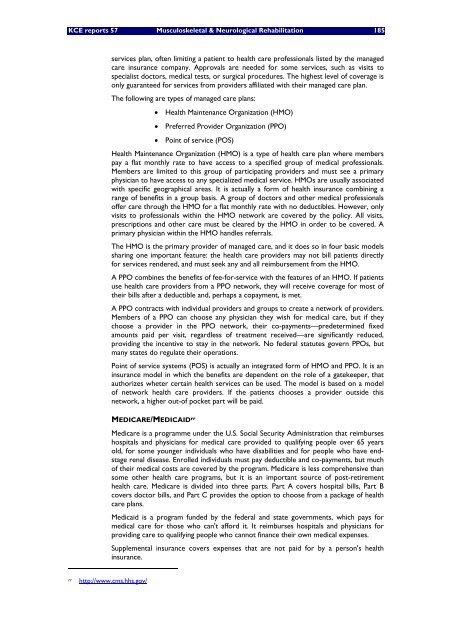The report is available in English with a French summary - KCE
The report is available in English with a French summary - KCE
The report is available in English with a French summary - KCE
Create successful ePaper yourself
Turn your PDF publications into a flip-book with our unique Google optimized e-Paper software.
<strong>KCE</strong> <strong>report</strong>s 57 Musculoskeletal & Neurological Rehabilitation 185<br />
rr http://www.cms.hhs.gov/<br />
services plan, often limit<strong>in</strong>g a patient to health care professionals l<strong>is</strong>ted by the managed<br />
care <strong>in</strong>surance company. Approvals are needed for some services, such as v<strong>is</strong>its to<br />
special<strong>is</strong>t doctors, medical tests, or surgical procedures. <strong>The</strong> highest level of coverage <strong>is</strong><br />
only guaranteed for services from providers affiliated <strong>with</strong> their managed care plan.<br />
<strong>The</strong> follow<strong>in</strong>g are types of managed care plans:<br />
• Health Ma<strong>in</strong>tenance Organization (HMO)<br />
• Preferred Provider Organization (PPO)<br />
• Po<strong>in</strong>t of service (POS)<br />
Health Ma<strong>in</strong>tenance Organization (HMO) <strong>is</strong> a type of health care plan where members<br />
pay a flat monthly rate to have access to a specified group of medical professionals.<br />
Members are limited to th<strong>is</strong> group of participat<strong>in</strong>g providers and must see a primary<br />
physician to have access to any specialized medical service. HMOs are usually associated<br />
<strong>with</strong> specific geographical areas. It <strong>is</strong> actually a form of health <strong>in</strong>surance comb<strong>in</strong><strong>in</strong>g a<br />
range of benefits <strong>in</strong> a group bas<strong>is</strong>. A group of doctors and other medical professionals<br />
offer care through the HMO for a flat monthly rate <strong>with</strong> no deductibles. However, only<br />
v<strong>is</strong>its to professionals <strong>with</strong><strong>in</strong> the HMO network are covered by the policy. All v<strong>is</strong>its,<br />
prescriptions and other care must be cleared by the HMO <strong>in</strong> order to be covered. A<br />
primary physician <strong>with</strong><strong>in</strong> the HMO handles referrals.<br />
<strong>The</strong> HMO <strong>is</strong> the primary provider of managed care, and it does so <strong>in</strong> four basic models<br />
shar<strong>in</strong>g one important feature: the health care providers may not bill patients directly<br />
for services rendered, and must seek any and all reimbursement from the HMO.<br />
A PPO comb<strong>in</strong>es the benefits of fee-for-service <strong>with</strong> the features of an HMO. If patients<br />
use health care providers from a PPO network, they will receive coverage for most of<br />
their bills after a deductible and, perhaps a copayment, <strong>is</strong> met.<br />
A PPO contracts <strong>with</strong> <strong>in</strong>dividual providers and groups to create a network of providers.<br />
Members of a PPO can choose any physician they w<strong>is</strong>h for medical care, but if they<br />
choose a provider <strong>in</strong> the PPO network, their co-payments—predeterm<strong>in</strong>ed fixed<br />
amounts paid per v<strong>is</strong>it, regardless of treatment received—are significantly reduced,<br />
provid<strong>in</strong>g the <strong>in</strong>centive to stay <strong>in</strong> the network. No federal statutes govern PPOs, but<br />
many states do regulate their operations.<br />
Po<strong>in</strong>t of service systems (POS) <strong>is</strong> actually an <strong>in</strong>tegrated form of HMO and PPO. It <strong>is</strong> an<br />
<strong>in</strong>surance model <strong>in</strong> which the benefits are dependent on the role of a gatekeeper, that<br />
authorizes wheter certa<strong>in</strong> health services can be used. <strong>The</strong> model <strong>is</strong> based on a model<br />
of network health care providers. If the patients chooses a provider outside th<strong>is</strong><br />
network, a higher out-of pocket part will be paid.<br />
MEDICARE/MEDICAID rr<br />
Medicare <strong>is</strong> a programme under the U.S. Social Security Adm<strong>in</strong><strong>is</strong>tration that reimburses<br />
hospitals and physicians for medical care provided to qualify<strong>in</strong>g people over 65 years<br />
old, for some younger <strong>in</strong>dividuals who have d<strong>is</strong>abilities and for people who have endstage<br />
renal d<strong>is</strong>ease. Enrolled <strong>in</strong>dividuals must pay deductible and co-payments, but much<br />
of their medical costs are covered by the program. Medicare <strong>is</strong> less comprehensive than<br />
some other health care programs, but it <strong>is</strong> an important source of post-retirement<br />
health care. Medicare <strong>is</strong> divided <strong>in</strong>to three parts. Part A covers hospital bills, Part B<br />
covers doctor bills, and Part C provides the option to choose from a package of health<br />
care plans.<br />
Medicaid <strong>is</strong> a program funded by the federal and state governments, which pays for<br />
medical care for those who can't afford it. It reimburses hospitals and physicians for<br />
provid<strong>in</strong>g care to qualify<strong>in</strong>g people who cannot f<strong>in</strong>ance their own medical expenses.<br />
Supplemental <strong>in</strong>surance covers expenses that are not paid for by a person's health<br />
<strong>in</strong>surance.

















